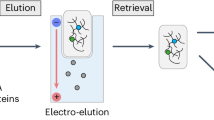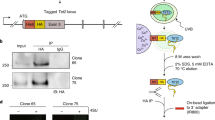Abstract
The 5-methylcytosine (5mC) oxidation pathway mediated by TET proteins involves step-wise oxidation of 5mC to 5-hydroxymethylcytosine (5hmC), 5-formylcytosine (5fC), and 5-carboxylcytosine (5caC). 5fC and 5caC can be removed from DNA by base excision repair and the completion of this pathway results in “demethylation” of 5mC by converting the modified base back into cytosine. In vitro studies with TET proteins aimed at analyzing their DNA substrate specificities and their activity within defined chromatin templates are relatively limited. Here we describe purification methods for mammalian TET proteins based on expression in insect cells or in 293T cells. We also briefly summarize a method that can be used to monitor 5-methylcytosine oxidase activity of the purified TET proteins in vitro.
Access this chapter
Tax calculation will be finalised at checkout
Purchases are for personal use only
Similar content being viewed by others
References
Wu X, Zhang Y (2017) TET-mediated active DNA demethylation: mechanism, function and beyond. Nat Rev Genet 18:517–534
Iurlaro M, von Meyenn F, Reik W (2017) DNA methylation homeostasis in human and mouse development. Curr Opin Genet Dev 43:101–109
Greenberg MVC, Bourc'his D (2019) The diverse roles of DNA methylation in mammalian development and disease. Nat Rev Mol Cell Biol 20:590–607
Jones PA, Baylin SB (2007) The epigenomics of cancer. Cell 128:683–692
Edwards JR, Yarychkivska O, Boulard M, Bestor TH (2017) DNA methylation and DNA methyltransferases. Epig Chrom 10:23
He YF, Li BZ, Li Z, Liu P, Wang Y, Tang Q et al (2011) Tet-mediated formation of 5-carboxylcytosine and its excision by TDG in mammalian DNA. Science 333:1303–1307
Ito S, Shen L, Dai Q, Wu SC, Collins LB, Swenberg JA et al (2011) Tet proteins can convert 5-methylcytosine to 5-formylcytosine and 5-carboxylcytosine. Science 333:1300–1303
Tahiliani M, Koh KP, Shen Y, Pastor WA, Bandukwala H, Brudno Y et al (2009) Conversion of 5-methylcytosine to 5-hydroxymethylcytosine in mammalian DNA by MLL partner TET1. Science 324:930–935
Ito S, D'Alessio AC, Taranova OV, Hong K, Sowers LC, Zhang Y (2010) Role of Tet proteins in 5mC to 5hmC conversion, ES-cell self-renewal and inner cell mass specification. Nature 466:1129–1133
Maiti A, Drohat AC (2011) Thymine DNA glycosylase can rapidly excise 5-formylcytosine and 5-carboxylcytosine: potential implications for active demethylation of CpG sites. J Biol Chem 286:35334–35338
Iqbal K, ** SG, Pfeifer GP, Szabo PE (2011) Reprogramming of the paternal genome upon fertilization involves genome-wide oxidation of 5-methylcytosine. Proc Natl Acad Sci U S A 108:3642–3647
Wossidlo M, Nakamura T, Lepikhov K, Marques CJ, Zakhartchenko V, Boiani M et al (2011) 5-Hydroxymethylcytosine in the mammalian zygote is linked with epigenetic reprogramming. Nat Commun 2:241
Hackett JA, Sengupta R, Zylicz JJ, Murakami K, Lee C, Down TA et al (2013) Germline DNA demethylation dynamics and imprint erasure through 5-hydroxymethylcytosine. Science 339:448–452
Hahn MA, ** SG, Li AX, Liu J, Huang Z, Wu X et al (2019) Reprogramming of DNA methylation at NEUROD2-bound sequences during cortical neuron differentiation. Sci Adv 5:eaax0080
Bogdanovic O, Smits AH, de la Calle Mustienes E, Tena JJ, Ford E, Williams R et al (2016) Active DNA demethylation at enhancers during the vertebrate phylotypic period. Nat Genet 48:417–426
Hon GC, Song CX, Du T, ** F, Selvaraj S, Lee AY et al (2014) 5mC oxidation by Tet2 modulates enhancer activity and timing of transcriptome reprogramming during differentiation. Mol Cell 56:286–297
Sardina JL, Collombet S, Tian TV, Gomez A, Di Stefano B, Berenguer C et al (2018) Transcription factors drive Tet2-mediated enhancer demethylation to reprogram cell fate. Cell Stem Cell 23:727–741. e729
Rasmussen KD, Jia G, Johansen JV, Pedersen MT, Rapin N, Bagger FO et al (2015) Loss of TET2 in hematopoietic cells leads to DNA hypermethylation of active enhancers and induction of leukemogenesis. Genes Dev 29:910–922
Wang L, Ozark PA, Smith ER, Zhao Z, Marshall SA, Rendleman EJ et al (2018) TET2 coactivates gene expression through demethylation of enhancers. Sci Adv 4:eaau6986
Song J, Pfeifer GP (2016) Are there specific readers of oxidized 5-methylcytosine bases? BioEssays 38:1038–1047
** SG, Kadam S, Pfeifer GP (2010) Examination of the specificity of DNA methylation profiling techniques towards 5-methylcytosine and 5-hydroxymethylcytosine. Nucleic Acids Res 38:e125
Abdel-Wahab O, Mullally A, Hedvat C, Garcia-Manero G, Patel J, Wadleigh M et al (2009) Genetic characterization of TET1, TET2, and TET3 alterations in myeloid malignancies. Blood 114:144–147
** SG, Jiang Y, Qiu R, Rauch TA, Wang Y, Schackert G et al (2011) 5-Hydroxymethylcytosine is strongly depleted in human cancers but its levels do not correlate with IDH1 mutations. Cancer Res 71:7360–7365
An J, Rao A, Ko M (2017) TET family dioxygenases and DNA demethylation in stem cells and cancers. Exp Mol Med 49:e323
Gu TP, Guo F, Yang H, Wu HP, Xu GF, Liu W et al (2011) The role of Tet3 DNA dioxygenase in epigenetic reprogramming by oocytes. Nature 477:606–610
Dai HQ, Wang BA, Yang L, Chen JJ, Zhu GC, Sun ML et al (2016) TET-mediated DNA demethylation controls gastrulation by regulating lefty-nodal signalling. Nature 538:528–532
** SG, Zhang ZM, Dunwell TL, Harter MR, Wu X, Johnson J et al (2016) Tet3 reads 5-Carboxylcytosine through its CXXC domain and is a potential Guardian against neurodegeneration. Cell Rep 14:493–505
Zhang W, **a W, Wang Q, Towers AJ, Chen J, Gao R et al (2016) Isoform switch of TET1 regulates DNA demethylation and mouse development. Mol Cell 64:1062–1073
Long HK, Blackledge NP, Klose RJ (2013) ZF-CxxC domain-containing proteins, CpG islands and the chromatin connection. Biochem Soc Trans 41:727–740
Ko M, An J, Bandukwala HS, Chavez L, Aijo T, Pastor WA et al (2013) Modulation of TET2 expression and 5-methylcytosine oxidation by the CXXC domain protein IDAX. Nature 497:122–126
Yu M, Hon GC, Szulwach KE, Song CX, Zhang L, Kim A et al (2012) Base-resolution analysis of 5-hydroxymethylcytosine in the mammalian genome. Cell 149:1368–1380
Hahn MA, Li AX, Wu X, Pfeifer GP (2015) Single base resolution analysis of 5-methylcytosine and 5-hydroxymethylcytosine by RRBS and TAB-RRBS. Methods Mol Biol 1238:273–287
Liu MY, Torabifard H, Crawford DJ, DeNizio JE, Cao XJ, Garcia BA et al (2017) Mutations along a TET2 active site scaffold stall oxidation at 5-hydroxymethylcytosine. Nat Chem Biol 13:181–187
Hu L, Li Z, Cheng J, Rao Q, Gong W, Liu M et al (2013) Crystal structure of TET2-DNA complex: insight into TET-mediated 5mC oxidation. Cell 155:1545–1555
Author information
Authors and Affiliations
Corresponding author
Editor information
Editors and Affiliations
Rights and permissions
Copyright information
© 2021 Springer Science+Business Media, LLC, part of Springer Nature
About this protocol
Cite this protocol
Huang, Z., Yu, J., Johnson, J., **, SG., Pfeifer, G.P. (2021). Purification of TET Proteins . In: Bogdanovic, O., Vermeulen, M. (eds) TET Proteins and DNA Demethylation. Methods in Molecular Biology, vol 2272. Humana, New York, NY. https://doi.org/10.1007/978-1-0716-1294-1_13
Download citation
DOI: https://doi.org/10.1007/978-1-0716-1294-1_13
Published:
Publisher Name: Humana, New York, NY
Print ISBN: 978-1-0716-1293-4
Online ISBN: 978-1-0716-1294-1
eBook Packages: Springer Protocols




